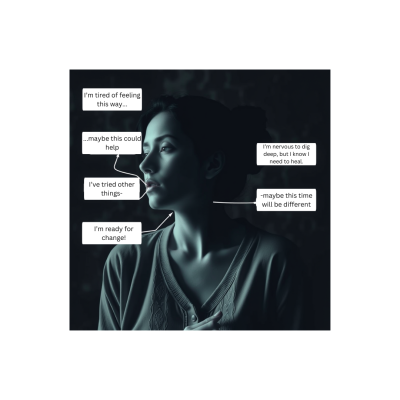Blog
Breathwork for Mood Disorders: A Safe Approach to Emotional Healing

Breathwork for Mood Disorders: A Safe Approach to Emotional Healing
Breathwork is gaining recognition for its therapeutic benefits, especially for individuals with mood disorders like depression, anxiety, or bipolar disorder. As a Certified Introspective Breathwork® therapist, I have seen firsthand how safe and guided breathwork can help individuals access their emotions, regulate stress, and foster healing. However, for those with mood disorders, it’s essential to approach breathwork mindfully.
Understanding Mood Disorders and Breathwork
Mood disorders, such as depression and bipolar disorder, deeply impact emotional and physical well-being. They can make it challenging to regulate emotions, causing intense emotional swings, prolonged sadness, or heightened anxiety. People with mood disorders may experience difficulty processing their emotions, often feeling stuck or overwhelmed. Traditional talk therapies can be effective, but incorporating safe breathwork practices can enhance healing by directly working with the body and the nervous system.
Coherent breathing, the foundation of Introspective Breathwork® therapy, focuses on maintaining a slow, rhythmic breathing pattern (around 5-6 breaths per minute) that helps balance the nervous system. When practiced safely, this can help regulate emotions, reduce stress, and foster self-awareness. However, breathwork must be adapted to the individual’s needs, especially for those with certain physical or mental health conditions. For those with mood disorders, it’s important to avoid overstimulation or sudden changes in breathing patterns that might destabilize mood or trigger anxiety.
The Importance of Vulnerability in Breathwork Therapy
Breathwork is more than just a physical practice; it requires an emotional willingness to open up and explore the depths of your inner world. For clients dealing with mood disorders, being vulnerable and open during therapy is essential to unlocking the full benefits of the practice. It’s in this vulnerable state that true emotional healing occurs, allowing clients to release suppressed emotions, overcome mental blocks, and connect with their authentic selves.
Being vulnerable means confronting discomfort, which can feel overwhelming. However, when done in a safe, supportive environment, this vulnerability is the gateway to healing. As an Introspective Breathwork® therapist, I create a space where clients can feel safe to open up and embrace their journey toward emotional balance.
Tailoring Breathwork for Safe Emotional Healing
In Introspective Breathwork®, we use coherent breathing as a foundational technique. This slow, rhythmic breathing pattern (5-6 breaths per minute) helps balance the autonomic nervous system, promoting calmness and emotional regulation. For those with mood disorders, this can be a transformative practice when guided safely.
However, breathwork practices that involve rapid shifts in breathing patterns or breath retention can be too intense for some individuals. That’s why I tailor the practice to each client’s emotional and physical needs, ensuring the experience is supportive, grounding, and never overwhelming.
What We Focus On:
- Slow, circular breathing patterns that help promote a sense of calm.
- Gradual emotional release while maintaining a sense of safety and control.
- Customized breathwork journeys that meet the individual where they are emotionally, allowing them to engage at their own pace.
Why Choose Introspective Breathwork® Therapy?
Introspective Breathwork® is a form of breathwork that dives deeply into the subconscious, helping individuals release emotional blockages and gain clarity. By approaching each session with trauma sensitivity, I ensure that clients with mood disorders, such as depression or anxiety, receive the care and support they need to feel grounded and in control.
Whether you’re struggling with the highs and lows of bipolar disorder or feeling weighed down by the heaviness of depression, breathwork therapy can be a transformative experience—when done with the right guidance and attention to individual needs. The more open and vulnerable you are in the process, the deeper your healing can go.
- A study from Harvard Medical School highlights that coherent breathing (5-6 breaths per minute) can improve emotional regulation by balancing the autonomic nervous system.
- A 2018 study published in the Journal of Clinical Psychology found that breathwork practices, particularly those that focus on slow, rhythmic breathing, reduce symptoms of depression and anxiety in individuals with mood disorders .
- The National Alliance on Mental Illness (NAMI) recommends guided breathwork as a supplemental treatment for mood disorders, emphasizing the importance of tailoring the practice to the individual’s needs.
- A 2021 study in Frontiers in Human Neuroscience found that individuals who practice emotional vulnerability in therapy experience greater improvements in their emotional well-being and overall mental health.
- Dr. Kristin Neff, a pioneer in the field of self-compassion research, emphasizes that being vulnerable and open to emotional experiences is a critical component of healing from trauma and emotional dysregulation.
Take the First Step Toward Emotional Healing
If you’re living with a mood disorder and are curious about how Introspective Breathwork® therapy can help you, reach out to explore how we can work together. By personalizing your breathwork journey and providing a safe space to be vulnerable, we can ensure a supportive and transformative process that honors your unique emotional needs and health concerns.
